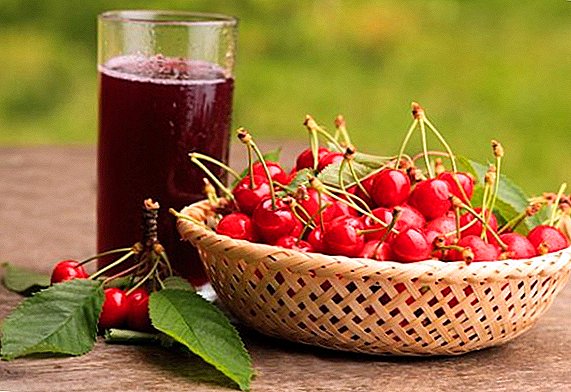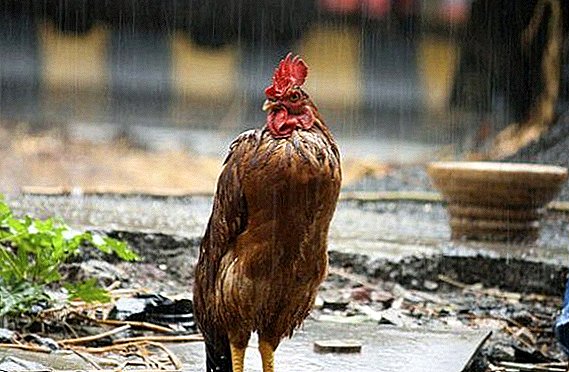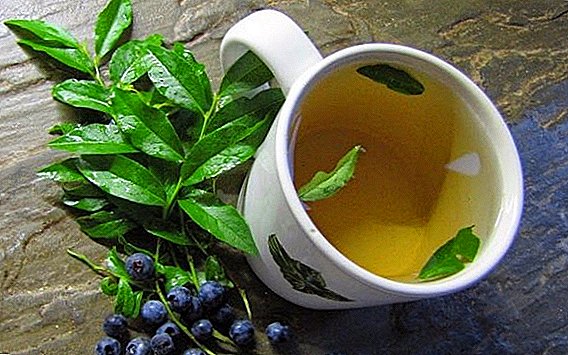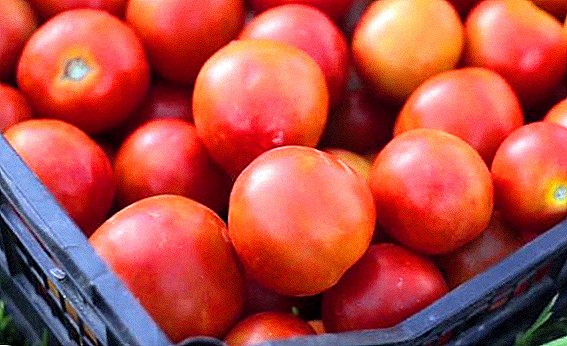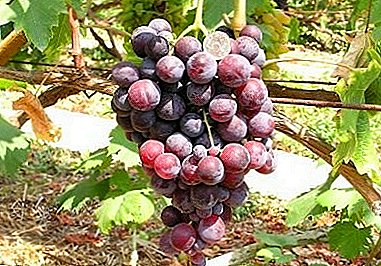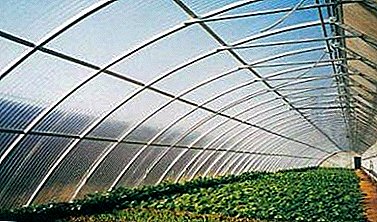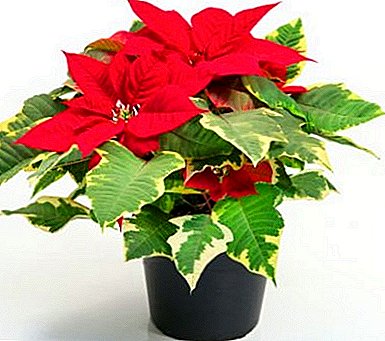
Poinsettia (Euphorbia finest) - a plant with a bright leaf rosette very similar to a flower, quickly gained popularity among gardeners.
Its decorative appearance is able to become an ornament to any interior. Especially he gives them a festivity on the eve of Christmas and New Year.
And its name - Christmas Star - the flower received because of the time of flowering. Its central leaves are painted in bright colors on the eve of New Year's celebrations.
This element of decor, traditional in Europe, is increasingly found in the homes of Russians. And for the flowering of the Star of Bethlehem in your home you just need to create certain conditions.
How does bloom?
Flowers do not give a particular decorative effect to this plant, they are unattractive, small in Poinsettia. Beauty is given by a leaf rosette located in the center of the stem around the inflorescence. It can be bright red, white and pink, lilac, cream.
The color lasts up to 6 months, then changes to green, and the leaves fall. Leaf dyeing begins in late November - early December. Poinsettia appears in all its glory for the New Year holidays.
TIP. Get the most beautiful Euphorbia only in stores where it's warm. Do not buy copies that are sold on the street or in cold stalls - such a plant will delight you with a bright flower inflorescence, similar to a Bethlehem star, not at all for long.
Look at the flowers in the center of the stem. If they have already blossomed, give up the purchase, such a plant will not be able to keep the leaves for a long time, since the growing season has come to an end. Choose copies with buds in the center of the colored rosette of leaves.
Conditions for flowering at home
 To make Poinsettia blossom, give it maximum attention at home. It needs to be grown at average air temperature. The flower does not like heat, but cold (below plus 16) is contraindicated. It is also impossible to prevent temperature fluctuations, because of this the plant will lose foliage.
To make Poinsettia blossom, give it maximum attention at home. It needs to be grown at average air temperature. The flower does not like heat, but cold (below plus 16) is contraindicated. It is also impossible to prevent temperature fluctuations, because of this the plant will lose foliage.
Good lighting Poinsettia is also necessary, put it in the most bright place in the apartment. Water the plant regularly, as the topsoil dries. Avoid stagnant water in the pan.
Indoor air should not be dry, poinsettia loves heat and humidity. To make her feel good, spray around her with warm water every one or two days. Do not splash water on the leaves, they will be covered with ugly spots.
It needs flower and protection from drafts - it can drop the leaves from the ingress of cold air, even for a short time.
IMPORTANT. When you purchased Poinsettia, do not replant it like other plants in a new soil and new pot. This can be done only after flowering.
Periods of growth
Leaf drop
At the end of the growing season, even if the leaves do not color, Poinsettia drops all leaves. But this does not mean that the plant should be thrown away. From January to May, she is being cared for as usual.. Water regularly, often sprayed the air.
In April, reduce watering, the soil between watering should dry out. Spraying is not performed. At this time, the temperature is reduced to 15 degrees. The plant begins to gradually lose leaves. It lasts about a month.
As soon as the leaves fall off, cut the stems at a height of 10 cm from the ground and put the pot in a cool dark place. Poinsettia is resting. Watering it at this time is not necessary. You can moisten the soil once or twice lightly, if the room is very dry.
Vegetation
In May, Poinsettia is transplanted by transferring to a larger pot. Do not take the capacity much more previous. Try not to injure the roots during transplantation. Soil for transplantation should consist of peat - 2 parts, sod mixture - 1 part, coarse sand - 1 part. To improve the nutritional properties of the substrate, add long-acting fertilizer.
When transplanting, do not forget to put a large layer of drainage on the bottom of the pot. Poinsettia does not tolerate waterlogged soil, the roots of this can rot.
Increase watering gradually. When the first seedlings appear, regular spraying of air begins. During active growth, the plant must be fed every two weeks. But such a frequency is necessary if you did not add fertilizer to the soil. Feeding is carried out with both mineral and organic fertilizers.. Give preference to fertilizer mixtures for flowering plants.
 During the period of stalk growth, inspect Poinsettia for the appearance of diseases and pests. Whitefly, fungus mosquitoes, spider mites, mealybugs can damage the plant. At the first sign of their appearance, treat the flower with insecticides.
During the period of stalk growth, inspect Poinsettia for the appearance of diseases and pests. Whitefly, fungus mosquitoes, spider mites, mealybugs can damage the plant. At the first sign of their appearance, treat the flower with insecticides.
For good growth, Poinsettia needs at least 4-5 hours of sunshine per day.
From June to August, the plant can be carried out on the balcony. Only direct sunlight on it should not fall, the leaves may suffer from this and fall. If you do not have a balcony, often ventilate the room where you grow a flower.
Continue to shorten the shoots. This will help to form new, and therefore the number of colored rosettes of leaves. The last pruning is carried out no later than mid-August. From this time begins the bookmark flower buds.
When pruning for flowering, leave 5-6 shoots, not more. Cut the remaining stems to the ground. Use pruned shoots to grow new ones.
Loosen the soil in the pot regularly so that the roots do not have oxygen starvation. In September, with the onset of cold nights, return the poinsettia to heat.
Rest period
Poinsettia blooms by the end of March. A beautiful flower exposes the stems, dropping all the leaves. Stop feeding plants and gradually reduce watering. Wait until the foliage shedding process is completed, and then cut off all the shoots, shortening them to 10 cm. This should be done in order for the root system to grow an essentially new copy.
Follow these rules for caring for Poinsettia, and the Christmas Star will give you its bright leaves in the winter frost. It will be a wonderful decoration of the New Year's table, will help to create a festive atmosphere and comfort.
 As mentioned earlier, Poinsettia belongs to the euphorbia family. Among her relatives there are many interesting plants grown in indoor conditions.
As mentioned earlier, Poinsettia belongs to the euphorbia family. Among her relatives there are many interesting plants grown in indoor conditions.On our site you will find a lot of useful information about such of them: Euphorbia White-faced and Euphorbia Brilliant.
A photo



The secrets of proper care
To make Poinsettia blossom, do the following:
- In October, start to limit the daylight hours. From 6-7 pm and until 7-8 am hide poinsettia from the light. You can put it in the closet, or build a dark box that cover the flower.
- Even under the light of an electric bulb, coloration of bracts may not occur.
- In the afternoon, continue to put the flower on the most illuminated place. Water and spray as usual. Feed regularly
- In this mode, keep poinsettia for at least 10 weeks.
- As soon as you notice the appearance of flower buds, and on the leaves there are signs of staining, stop darkening.
- Also stop feeding the flower.
- To bloom lasted longer, keep the temperature below the recommended rate.
Under these conditions, your beauty will bloom from 4 to 6 months.
You can often hear the question: "Why do not the leaves turn red at Poinsettia?».
Perhaps she does not blush due to lack of light and heat. Also a strong stress for this flower is changing places during the formation of buds. Do not move the flower from place to place.
 As you know, Poinsettia belongs to an extensive group of plants called succulents. Among them are many interesting specimens.
As you know, Poinsettia belongs to an extensive group of plants called succulents. Among them are many interesting specimens.We present to your attention a Desert rose or Adenium, a beautiful, but poisonous flower.
- Verbena. Poinsettia - exclusively indoor plant. However, sometimes we need a bright flower variety for a flower bed or a summer terrace.
And in this case, verbena comes to the rescue. In addition to the multicolor coloring, the main advantage of the verbena is its unpretentiousness. It is even able to withstand frosts down to -4 degrees.
- Gloxinia. This beauty with flowers, bells of bright colors can become a real decoration of our window sills.
Dozens of varieties with flowers from white to dark maroon, from pale lilac to dark purple. The main feature of Gloxinia is that it needs a winter rest, at this time the above-ground parts die off and only the life glows radically, ready to wake up in the spring.
- Gerbera. This African daisy is distinguished by a special delicacy of flowers. All the colors of the rainbow are imprinted on its lepes.
The heat-loving plant has completely settled down under room conditions and pleases us with its views with simple, double, needle-like petals. Its peculiarity is sensitivity to watering, dislike of direct sunlight.





